Analysis of Transformational Leadership and Employee Well-being in HRM
VerifiedAdded on 2023/04/23
|8
|2150
|383
Report
AI Summary
This report provides a critical review of the research paper "How do transformational leaders influence followers’ affective well-being? Exploring the mediating role of self-efficacy." The research aims to investigate the relationship between transformational leadership and employee well-being, with a focus on the mediating role of self-efficacy. The study employs a longitudinal survey design, collecting data from healthcare workers in a Danish local government. The findings suggest a positive correlation between transformational leadership and employee well-being, mediated by self-efficacy. The report analyzes the research methodology, including the theoretical model, data analysis techniques, and statistical methods used to test the hypotheses. It also discusses the significance of the article, theoretical model, data analysis, and findings. The analysis highlights the importance of self-efficacy in the workplace and its link to leadership styles and organizational performance. The report also discusses the limitations of the study, such as the low response rate, and the potential for the results to differ in other sectors. The report concludes by emphasizing the need for effective leadership training and the development of positive behavioral characteristics in leaders to improve employee well-being and organizational outcomes.
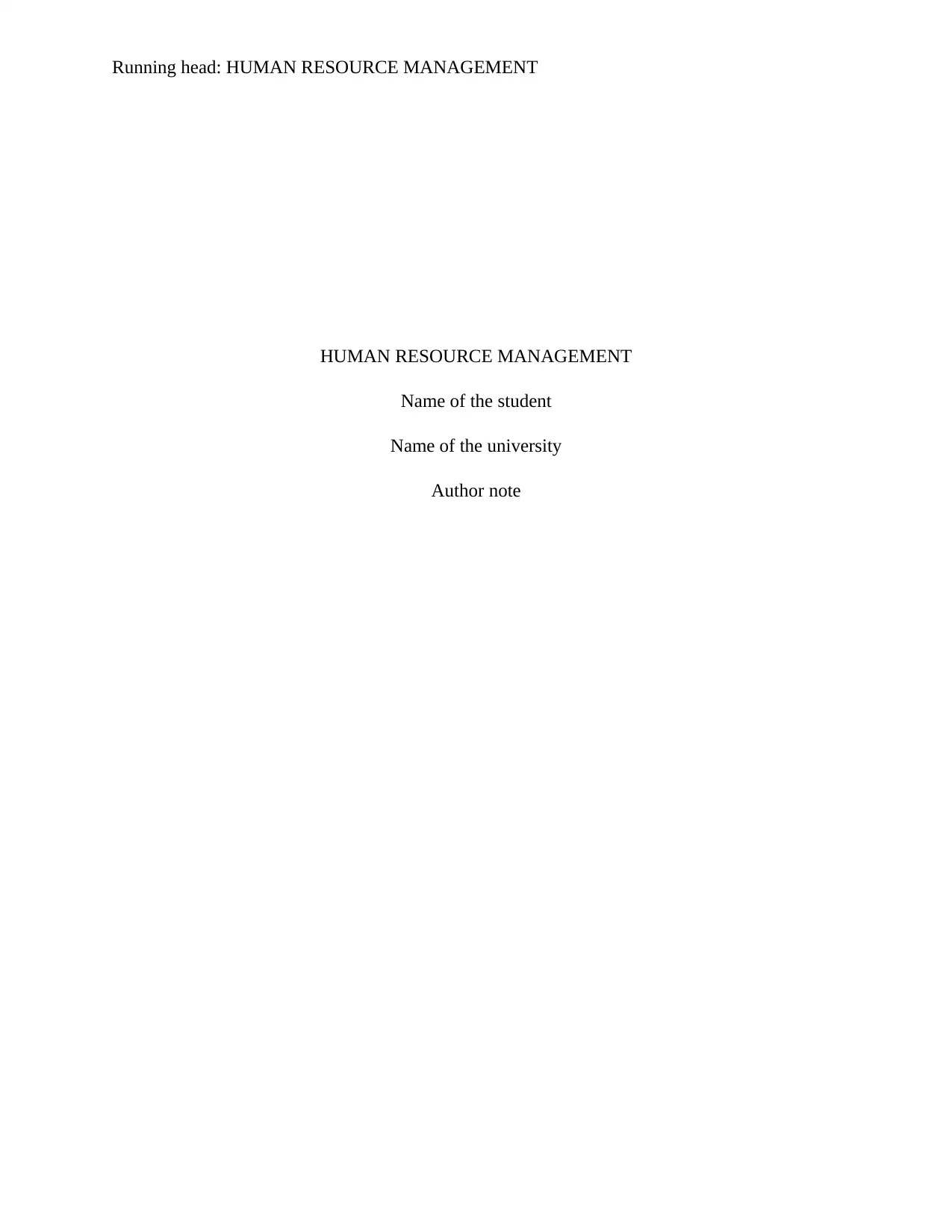
Running head: HUMAN RESOURCE MANAGEMENT
HUMAN RESOURCE MANAGEMENT
Name of the student
Name of the university
Author note
HUMAN RESOURCE MANAGEMENT
Name of the student
Name of the university
Author note
Paraphrase This Document
Need a fresh take? Get an instant paraphrase of this document with our AI Paraphraser
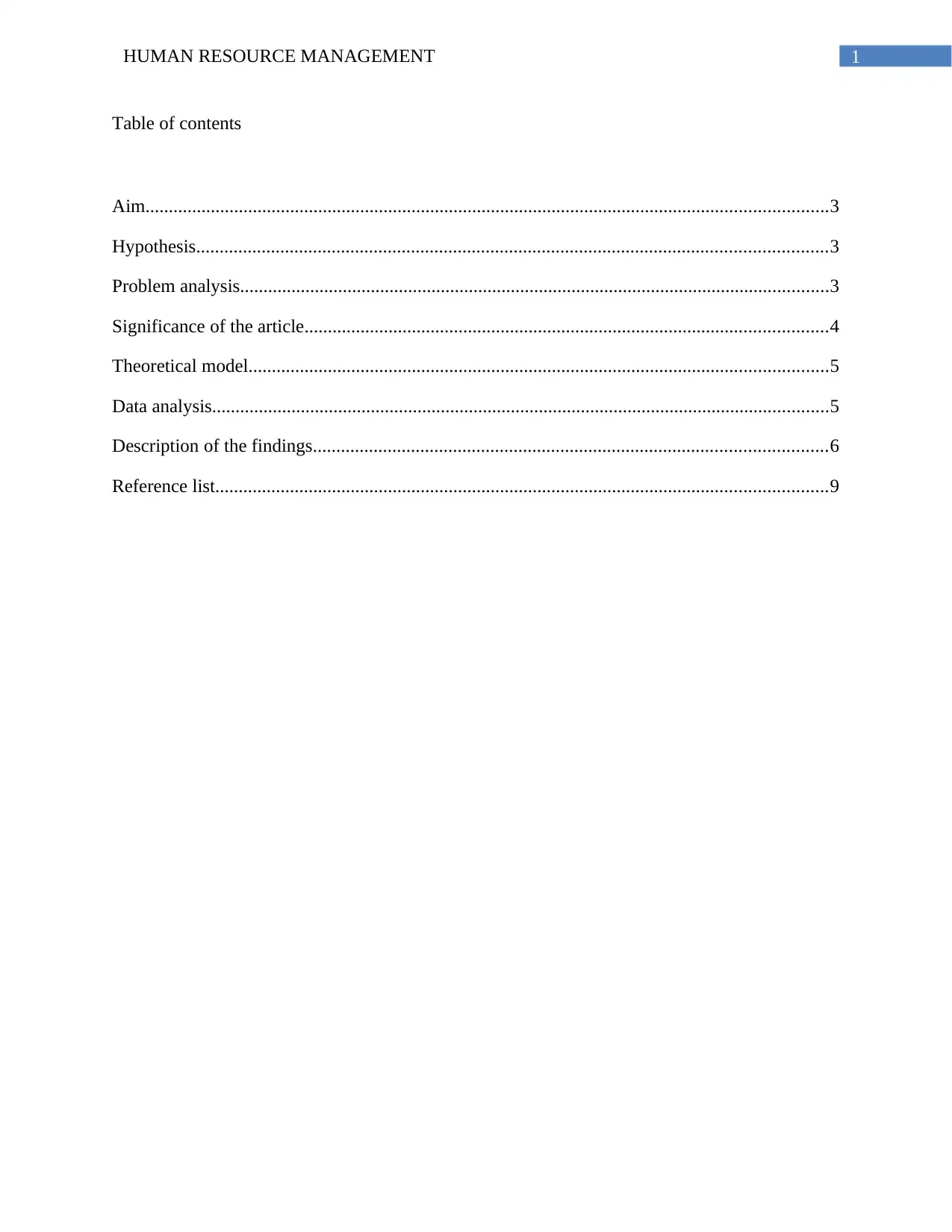
1HUMAN RESOURCE MANAGEMENT
Table of contents
Aim..................................................................................................................................................3
Hypothesis.......................................................................................................................................3
Problem analysis..............................................................................................................................3
Significance of the article................................................................................................................4
Theoretical model............................................................................................................................5
Data analysis....................................................................................................................................5
Description of the findings..............................................................................................................6
Reference list...................................................................................................................................9
Table of contents
Aim..................................................................................................................................................3
Hypothesis.......................................................................................................................................3
Problem analysis..............................................................................................................................3
Significance of the article................................................................................................................4
Theoretical model............................................................................................................................5
Data analysis....................................................................................................................................5
Description of the findings..............................................................................................................6
Reference list...................................................................................................................................9
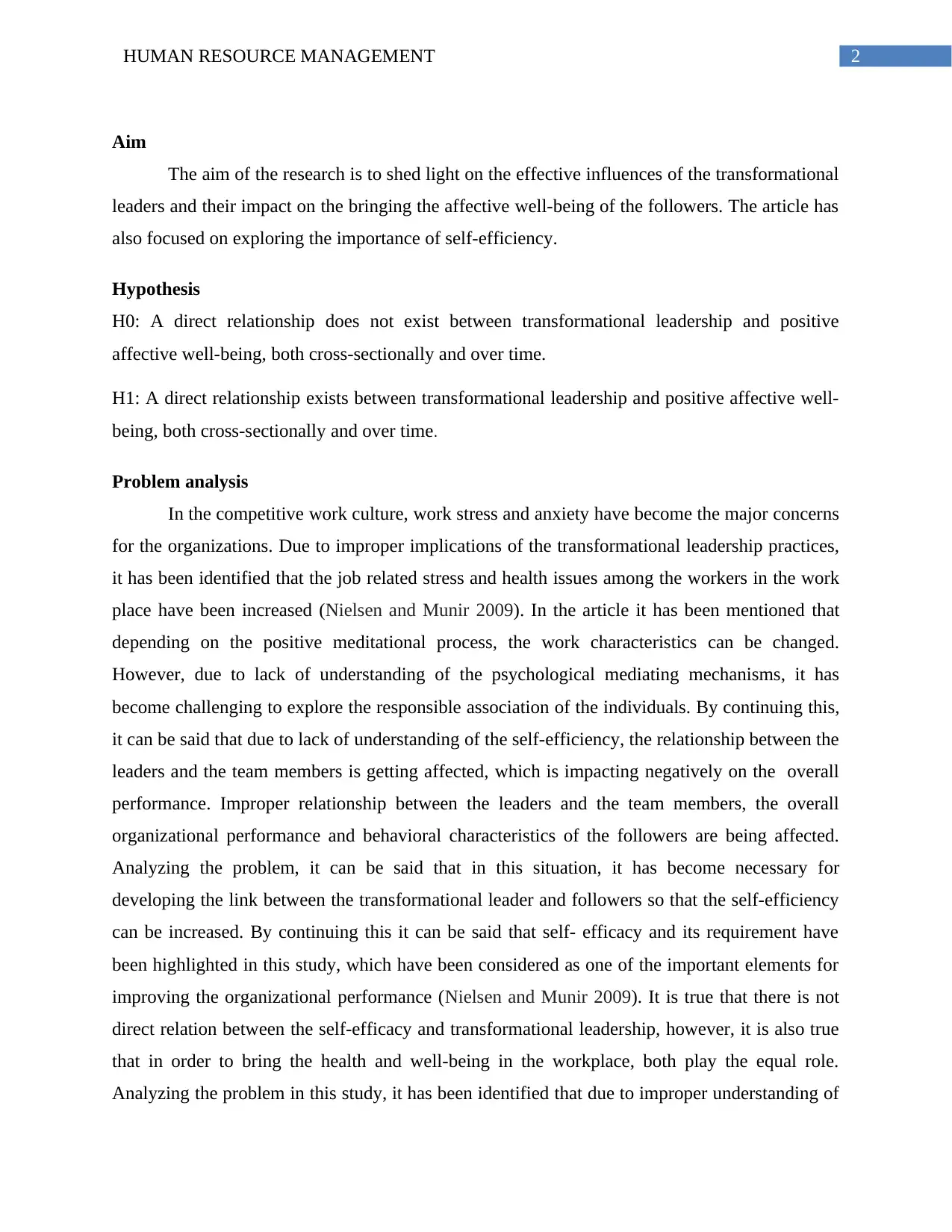
2HUMAN RESOURCE MANAGEMENT
Aim
The aim of the research is to shed light on the effective influences of the transformational
leaders and their impact on the bringing the affective well-being of the followers. The article has
also focused on exploring the importance of self-efficiency.
Hypothesis
H0: A direct relationship does not exist between transformational leadership and positive
affective well-being, both cross-sectionally and over time.
H1: A direct relationship exists between transformational leadership and positive affective well-
being, both cross-sectionally and over time.
Problem analysis
In the competitive work culture, work stress and anxiety have become the major concerns
for the organizations. Due to improper implications of the transformational leadership practices,
it has been identified that the job related stress and health issues among the workers in the work
place have been increased (Nielsen and Munir 2009). In the article it has been mentioned that
depending on the positive meditational process, the work characteristics can be changed.
However, due to lack of understanding of the psychological mediating mechanisms, it has
become challenging to explore the responsible association of the individuals. By continuing this,
it can be said that due to lack of understanding of the self-efficiency, the relationship between the
leaders and the team members is getting affected, which is impacting negatively on the overall
performance. Improper relationship between the leaders and the team members, the overall
organizational performance and behavioral characteristics of the followers are being affected.
Analyzing the problem, it can be said that in this situation, it has become necessary for
developing the link between the transformational leader and followers so that the self-efficiency
can be increased. By continuing this it can be said that self- efficacy and its requirement have
been highlighted in this study, which have been considered as one of the important elements for
improving the organizational performance (Nielsen and Munir 2009). It is true that there is not
direct relation between the self-efficacy and transformational leadership, however, it is also true
that in order to bring the health and well-being in the workplace, both play the equal role.
Analyzing the problem in this study, it has been identified that due to improper understanding of
Aim
The aim of the research is to shed light on the effective influences of the transformational
leaders and their impact on the bringing the affective well-being of the followers. The article has
also focused on exploring the importance of self-efficiency.
Hypothesis
H0: A direct relationship does not exist between transformational leadership and positive
affective well-being, both cross-sectionally and over time.
H1: A direct relationship exists between transformational leadership and positive affective well-
being, both cross-sectionally and over time.
Problem analysis
In the competitive work culture, work stress and anxiety have become the major concerns
for the organizations. Due to improper implications of the transformational leadership practices,
it has been identified that the job related stress and health issues among the workers in the work
place have been increased (Nielsen and Munir 2009). In the article it has been mentioned that
depending on the positive meditational process, the work characteristics can be changed.
However, due to lack of understanding of the psychological mediating mechanisms, it has
become challenging to explore the responsible association of the individuals. By continuing this,
it can be said that due to lack of understanding of the self-efficiency, the relationship between the
leaders and the team members is getting affected, which is impacting negatively on the overall
performance. Improper relationship between the leaders and the team members, the overall
organizational performance and behavioral characteristics of the followers are being affected.
Analyzing the problem, it can be said that in this situation, it has become necessary for
developing the link between the transformational leader and followers so that the self-efficiency
can be increased. By continuing this it can be said that self- efficacy and its requirement have
been highlighted in this study, which have been considered as one of the important elements for
improving the organizational performance (Nielsen and Munir 2009). It is true that there is not
direct relation between the self-efficacy and transformational leadership, however, it is also true
that in order to bring the health and well-being in the workplace, both play the equal role.
Analyzing the problem in this study, it has been identified that due to improper understanding of
⊘ This is a preview!⊘
Do you want full access?
Subscribe today to unlock all pages.

Trusted by 1+ million students worldwide
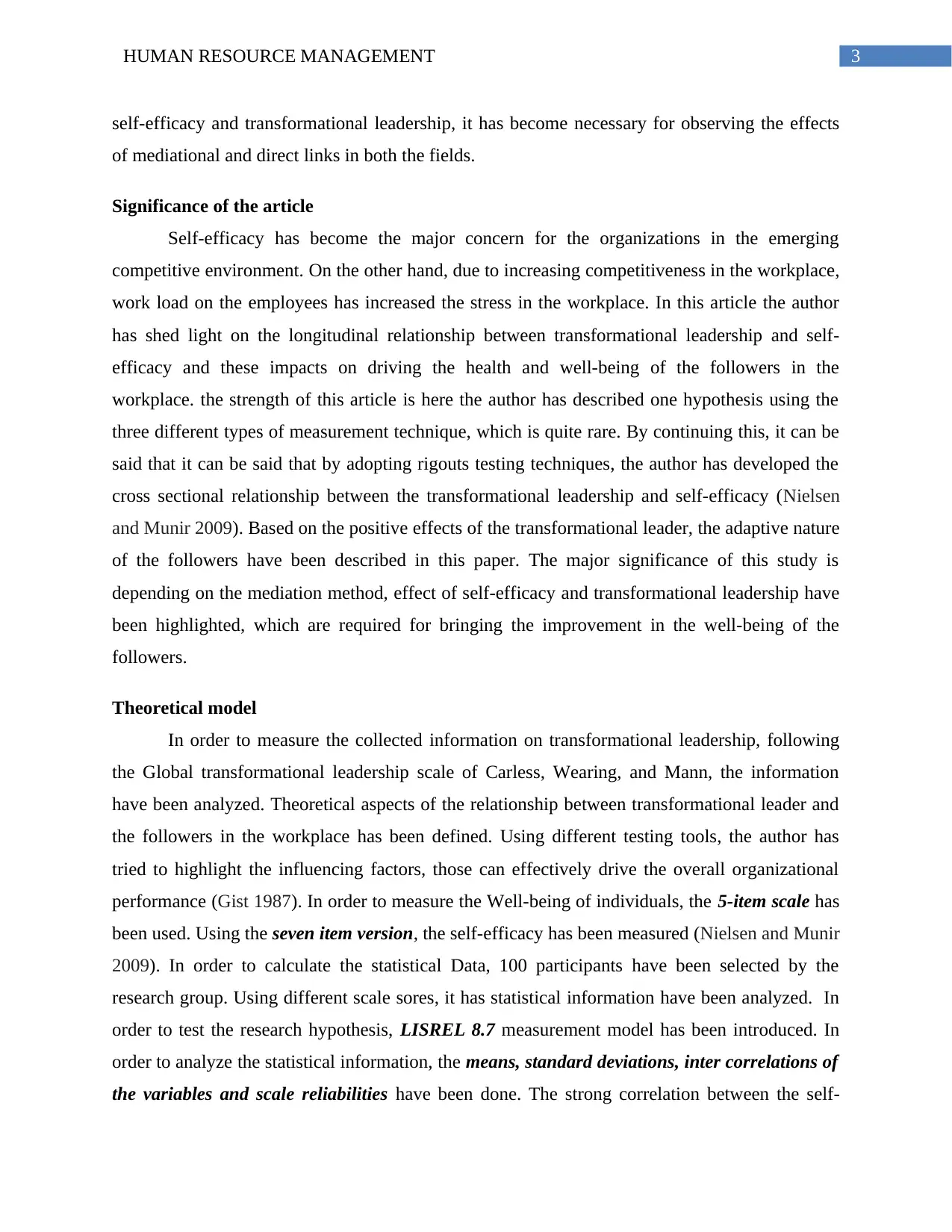
3HUMAN RESOURCE MANAGEMENT
self-efficacy and transformational leadership, it has become necessary for observing the effects
of mediational and direct links in both the fields.
Significance of the article
Self-efficacy has become the major concern for the organizations in the emerging
competitive environment. On the other hand, due to increasing competitiveness in the workplace,
work load on the employees has increased the stress in the workplace. In this article the author
has shed light on the longitudinal relationship between transformational leadership and self-
efficacy and these impacts on driving the health and well-being of the followers in the
workplace. the strength of this article is here the author has described one hypothesis using the
three different types of measurement technique, which is quite rare. By continuing this, it can be
said that it can be said that by adopting rigouts testing techniques, the author has developed the
cross sectional relationship between the transformational leadership and self-efficacy (Nielsen
and Munir 2009). Based on the positive effects of the transformational leader, the adaptive nature
of the followers have been described in this paper. The major significance of this study is
depending on the mediation method, effect of self-efficacy and transformational leadership have
been highlighted, which are required for bringing the improvement in the well-being of the
followers.
Theoretical model
In order to measure the collected information on transformational leadership, following
the Global transformational leadership scale of Carless, Wearing, and Mann, the information
have been analyzed. Theoretical aspects of the relationship between transformational leader and
the followers in the workplace has been defined. Using different testing tools, the author has
tried to highlight the influencing factors, those can effectively drive the overall organizational
performance (Gist 1987). In order to measure the Well-being of individuals, the 5-item scale has
been used. Using the seven item version, the self-efficacy has been measured (Nielsen and Munir
2009). In order to calculate the statistical Data, 100 participants have been selected by the
research group. Using different scale sores, it has statistical information have been analyzed. In
order to test the research hypothesis, LISREL 8.7 measurement model has been introduced. In
order to analyze the statistical information, the means, standard deviations, inter correlations of
the variables and scale reliabilities have been done. The strong correlation between the self-
self-efficacy and transformational leadership, it has become necessary for observing the effects
of mediational and direct links in both the fields.
Significance of the article
Self-efficacy has become the major concern for the organizations in the emerging
competitive environment. On the other hand, due to increasing competitiveness in the workplace,
work load on the employees has increased the stress in the workplace. In this article the author
has shed light on the longitudinal relationship between transformational leadership and self-
efficacy and these impacts on driving the health and well-being of the followers in the
workplace. the strength of this article is here the author has described one hypothesis using the
three different types of measurement technique, which is quite rare. By continuing this, it can be
said that it can be said that by adopting rigouts testing techniques, the author has developed the
cross sectional relationship between the transformational leadership and self-efficacy (Nielsen
and Munir 2009). Based on the positive effects of the transformational leader, the adaptive nature
of the followers have been described in this paper. The major significance of this study is
depending on the mediation method, effect of self-efficacy and transformational leadership have
been highlighted, which are required for bringing the improvement in the well-being of the
followers.
Theoretical model
In order to measure the collected information on transformational leadership, following
the Global transformational leadership scale of Carless, Wearing, and Mann, the information
have been analyzed. Theoretical aspects of the relationship between transformational leader and
the followers in the workplace has been defined. Using different testing tools, the author has
tried to highlight the influencing factors, those can effectively drive the overall organizational
performance (Gist 1987). In order to measure the Well-being of individuals, the 5-item scale has
been used. Using the seven item version, the self-efficacy has been measured (Nielsen and Munir
2009). In order to calculate the statistical Data, 100 participants have been selected by the
research group. Using different scale sores, it has statistical information have been analyzed. In
order to test the research hypothesis, LISREL 8.7 measurement model has been introduced. In
order to analyze the statistical information, the means, standard deviations, inter correlations of
the variables and scale reliabilities have been done. The strong correlation between the self-
Paraphrase This Document
Need a fresh take? Get an instant paraphrase of this document with our AI Paraphraser
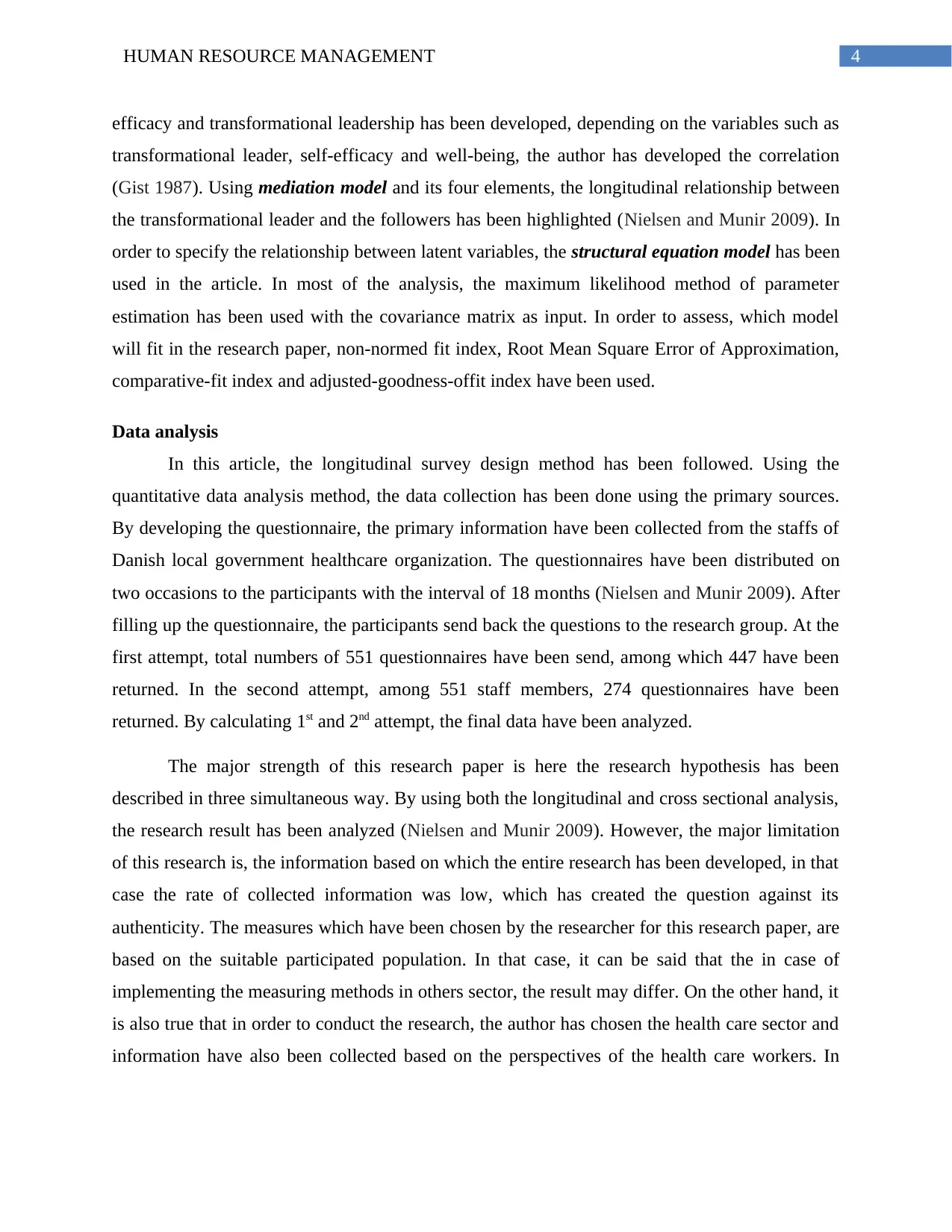
4HUMAN RESOURCE MANAGEMENT
efficacy and transformational leadership has been developed, depending on the variables such as
transformational leader, self-efficacy and well-being, the author has developed the correlation
(Gist 1987). Using mediation model and its four elements, the longitudinal relationship between
the transformational leader and the followers has been highlighted (Nielsen and Munir 2009). In
order to specify the relationship between latent variables, the structural equation model has been
used in the article. In most of the analysis, the maximum likelihood method of parameter
estimation has been used with the covariance matrix as input. In order to assess, which model
will fit in the research paper, non-normed fit index, Root Mean Square Error of Approximation,
comparative-fit index and adjusted-goodness-offit index have been used.
Data analysis
In this article, the longitudinal survey design method has been followed. Using the
quantitative data analysis method, the data collection has been done using the primary sources.
By developing the questionnaire, the primary information have been collected from the staffs of
Danish local government healthcare organization. The questionnaires have been distributed on
two occasions to the participants with the interval of 18 months (Nielsen and Munir 2009). After
filling up the questionnaire, the participants send back the questions to the research group. At the
first attempt, total numbers of 551 questionnaires have been send, among which 447 have been
returned. In the second attempt, among 551 staff members, 274 questionnaires have been
returned. By calculating 1st and 2nd attempt, the final data have been analyzed.
The major strength of this research paper is here the research hypothesis has been
described in three simultaneous way. By using both the longitudinal and cross sectional analysis,
the research result has been analyzed (Nielsen and Munir 2009). However, the major limitation
of this research is, the information based on which the entire research has been developed, in that
case the rate of collected information was low, which has created the question against its
authenticity. The measures which have been chosen by the researcher for this research paper, are
based on the suitable participated population. In that case, it can be said that the in case of
implementing the measuring methods in others sector, the result may differ. On the other hand, it
is also true that in order to conduct the research, the author has chosen the health care sector and
information have also been collected based on the perspectives of the health care workers. In
efficacy and transformational leadership has been developed, depending on the variables such as
transformational leader, self-efficacy and well-being, the author has developed the correlation
(Gist 1987). Using mediation model and its four elements, the longitudinal relationship between
the transformational leader and the followers has been highlighted (Nielsen and Munir 2009). In
order to specify the relationship between latent variables, the structural equation model has been
used in the article. In most of the analysis, the maximum likelihood method of parameter
estimation has been used with the covariance matrix as input. In order to assess, which model
will fit in the research paper, non-normed fit index, Root Mean Square Error of Approximation,
comparative-fit index and adjusted-goodness-offit index have been used.
Data analysis
In this article, the longitudinal survey design method has been followed. Using the
quantitative data analysis method, the data collection has been done using the primary sources.
By developing the questionnaire, the primary information have been collected from the staffs of
Danish local government healthcare organization. The questionnaires have been distributed on
two occasions to the participants with the interval of 18 months (Nielsen and Munir 2009). After
filling up the questionnaire, the participants send back the questions to the research group. At the
first attempt, total numbers of 551 questionnaires have been send, among which 447 have been
returned. In the second attempt, among 551 staff members, 274 questionnaires have been
returned. By calculating 1st and 2nd attempt, the final data have been analyzed.
The major strength of this research paper is here the research hypothesis has been
described in three simultaneous way. By using both the longitudinal and cross sectional analysis,
the research result has been analyzed (Nielsen and Munir 2009). However, the major limitation
of this research is, the information based on which the entire research has been developed, in that
case the rate of collected information was low, which has created the question against its
authenticity. The measures which have been chosen by the researcher for this research paper, are
based on the suitable participated population. In that case, it can be said that the in case of
implementing the measuring methods in others sector, the result may differ. On the other hand, it
is also true that in order to conduct the research, the author has chosen the health care sector and
information have also been collected based on the perspectives of the health care workers. In
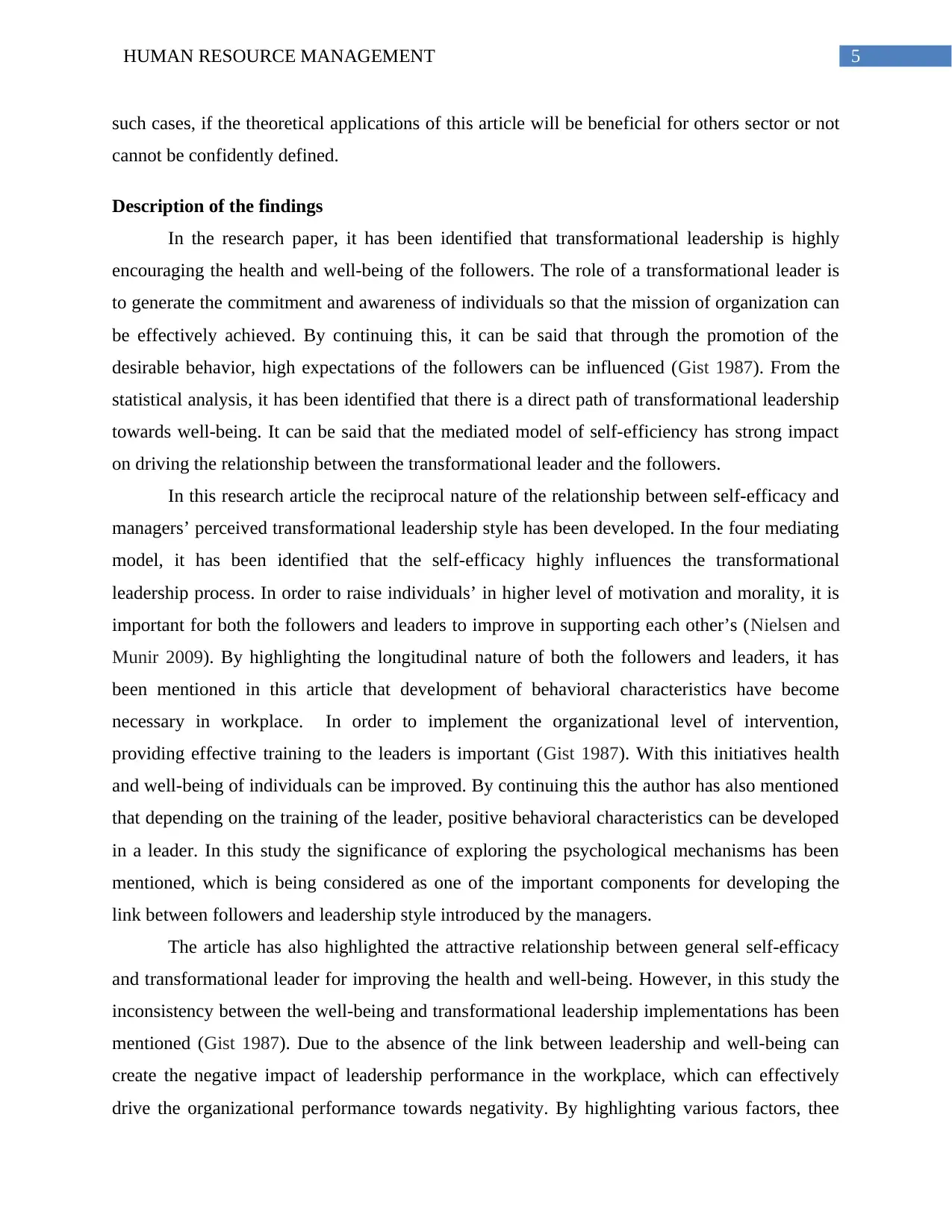
5HUMAN RESOURCE MANAGEMENT
such cases, if the theoretical applications of this article will be beneficial for others sector or not
cannot be confidently defined.
Description of the findings
In the research paper, it has been identified that transformational leadership is highly
encouraging the health and well-being of the followers. The role of a transformational leader is
to generate the commitment and awareness of individuals so that the mission of organization can
be effectively achieved. By continuing this, it can be said that through the promotion of the
desirable behavior, high expectations of the followers can be influenced (Gist 1987). From the
statistical analysis, it has been identified that there is a direct path of transformational leadership
towards well-being. It can be said that the mediated model of self-efficiency has strong impact
on driving the relationship between the transformational leader and the followers.
In this research article the reciprocal nature of the relationship between self-efficacy and
managers’ perceived transformational leadership style has been developed. In the four mediating
model, it has been identified that the self-efficacy highly influences the transformational
leadership process. In order to raise individuals’ in higher level of motivation and morality, it is
important for both the followers and leaders to improve in supporting each other’s (Nielsen and
Munir 2009). By highlighting the longitudinal nature of both the followers and leaders, it has
been mentioned in this article that development of behavioral characteristics have become
necessary in workplace. In order to implement the organizational level of intervention,
providing effective training to the leaders is important (Gist 1987). With this initiatives health
and well-being of individuals can be improved. By continuing this the author has also mentioned
that depending on the training of the leader, positive behavioral characteristics can be developed
in a leader. In this study the significance of exploring the psychological mechanisms has been
mentioned, which is being considered as one of the important components for developing the
link between followers and leadership style introduced by the managers.
The article has also highlighted the attractive relationship between general self-efficacy
and transformational leader for improving the health and well-being. However, in this study the
inconsistency between the well-being and transformational leadership implementations has been
mentioned (Gist 1987). Due to the absence of the link between leadership and well-being can
create the negative impact of leadership performance in the workplace, which can effectively
drive the organizational performance towards negativity. By highlighting various factors, thee
such cases, if the theoretical applications of this article will be beneficial for others sector or not
cannot be confidently defined.
Description of the findings
In the research paper, it has been identified that transformational leadership is highly
encouraging the health and well-being of the followers. The role of a transformational leader is
to generate the commitment and awareness of individuals so that the mission of organization can
be effectively achieved. By continuing this, it can be said that through the promotion of the
desirable behavior, high expectations of the followers can be influenced (Gist 1987). From the
statistical analysis, it has been identified that there is a direct path of transformational leadership
towards well-being. It can be said that the mediated model of self-efficiency has strong impact
on driving the relationship between the transformational leader and the followers.
In this research article the reciprocal nature of the relationship between self-efficacy and
managers’ perceived transformational leadership style has been developed. In the four mediating
model, it has been identified that the self-efficacy highly influences the transformational
leadership process. In order to raise individuals’ in higher level of motivation and morality, it is
important for both the followers and leaders to improve in supporting each other’s (Nielsen and
Munir 2009). By highlighting the longitudinal nature of both the followers and leaders, it has
been mentioned in this article that development of behavioral characteristics have become
necessary in workplace. In order to implement the organizational level of intervention,
providing effective training to the leaders is important (Gist 1987). With this initiatives health
and well-being of individuals can be improved. By continuing this the author has also mentioned
that depending on the training of the leader, positive behavioral characteristics can be developed
in a leader. In this study the significance of exploring the psychological mechanisms has been
mentioned, which is being considered as one of the important components for developing the
link between followers and leadership style introduced by the managers.
The article has also highlighted the attractive relationship between general self-efficacy
and transformational leader for improving the health and well-being. However, in this study the
inconsistency between the well-being and transformational leadership implementations has been
mentioned (Gist 1987). Due to the absence of the link between leadership and well-being can
create the negative impact of leadership performance in the workplace, which can effectively
drive the organizational performance towards negativity. By highlighting various factors, thee
⊘ This is a preview!⊘
Do you want full access?
Subscribe today to unlock all pages.

Trusted by 1+ million students worldwide
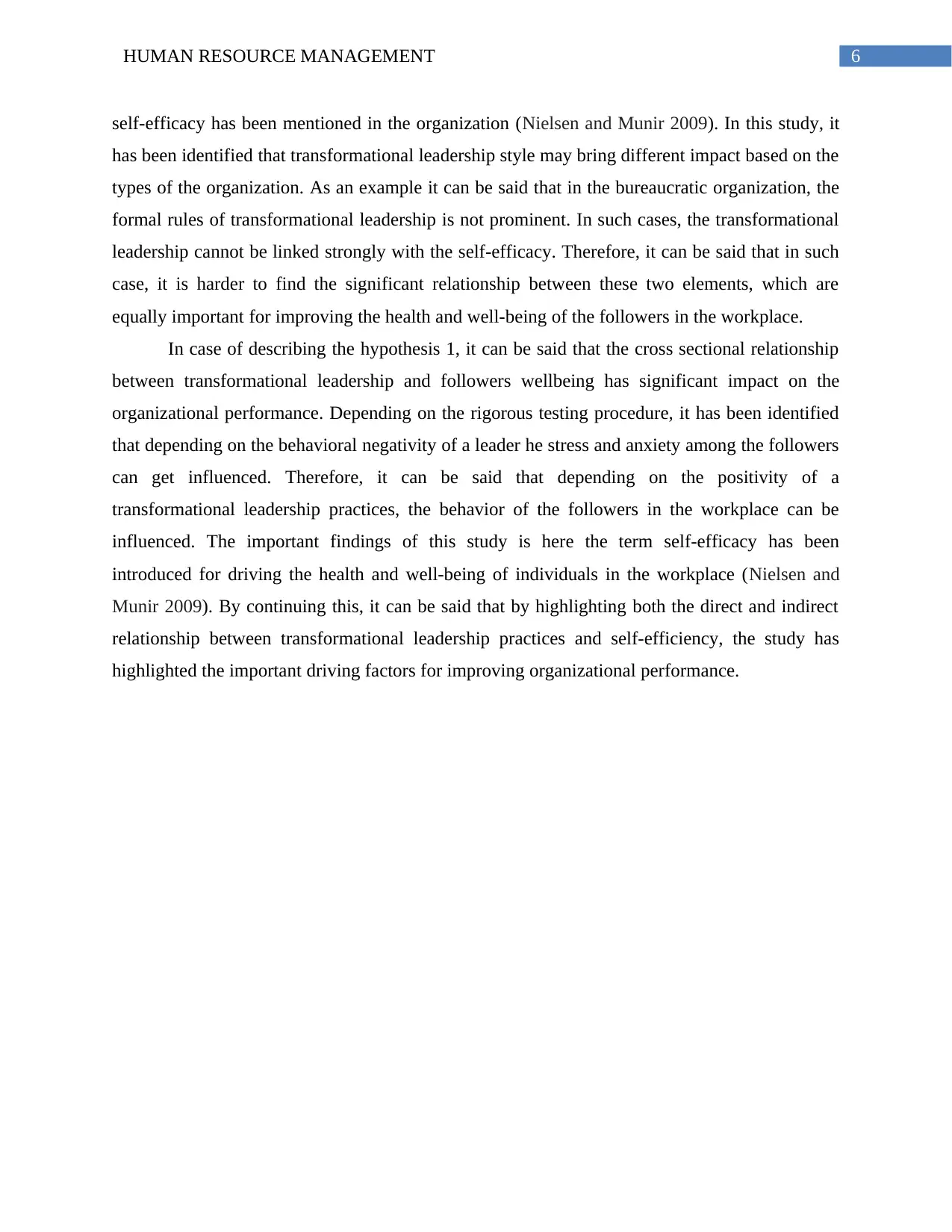
6HUMAN RESOURCE MANAGEMENT
self-efficacy has been mentioned in the organization (Nielsen and Munir 2009). In this study, it
has been identified that transformational leadership style may bring different impact based on the
types of the organization. As an example it can be said that in the bureaucratic organization, the
formal rules of transformational leadership is not prominent. In such cases, the transformational
leadership cannot be linked strongly with the self-efficacy. Therefore, it can be said that in such
case, it is harder to find the significant relationship between these two elements, which are
equally important for improving the health and well-being of the followers in the workplace.
In case of describing the hypothesis 1, it can be said that the cross sectional relationship
between transformational leadership and followers wellbeing has significant impact on the
organizational performance. Depending on the rigorous testing procedure, it has been identified
that depending on the behavioral negativity of a leader he stress and anxiety among the followers
can get influenced. Therefore, it can be said that depending on the positivity of a
transformational leadership practices, the behavior of the followers in the workplace can be
influenced. The important findings of this study is here the term self-efficacy has been
introduced for driving the health and well-being of individuals in the workplace (Nielsen and
Munir 2009). By continuing this, it can be said that by highlighting both the direct and indirect
relationship between transformational leadership practices and self-efficiency, the study has
highlighted the important driving factors for improving organizational performance.
self-efficacy has been mentioned in the organization (Nielsen and Munir 2009). In this study, it
has been identified that transformational leadership style may bring different impact based on the
types of the organization. As an example it can be said that in the bureaucratic organization, the
formal rules of transformational leadership is not prominent. In such cases, the transformational
leadership cannot be linked strongly with the self-efficacy. Therefore, it can be said that in such
case, it is harder to find the significant relationship between these two elements, which are
equally important for improving the health and well-being of the followers in the workplace.
In case of describing the hypothesis 1, it can be said that the cross sectional relationship
between transformational leadership and followers wellbeing has significant impact on the
organizational performance. Depending on the rigorous testing procedure, it has been identified
that depending on the behavioral negativity of a leader he stress and anxiety among the followers
can get influenced. Therefore, it can be said that depending on the positivity of a
transformational leadership practices, the behavior of the followers in the workplace can be
influenced. The important findings of this study is here the term self-efficacy has been
introduced for driving the health and well-being of individuals in the workplace (Nielsen and
Munir 2009). By continuing this, it can be said that by highlighting both the direct and indirect
relationship between transformational leadership practices and self-efficiency, the study has
highlighted the important driving factors for improving organizational performance.
Paraphrase This Document
Need a fresh take? Get an instant paraphrase of this document with our AI Paraphraser
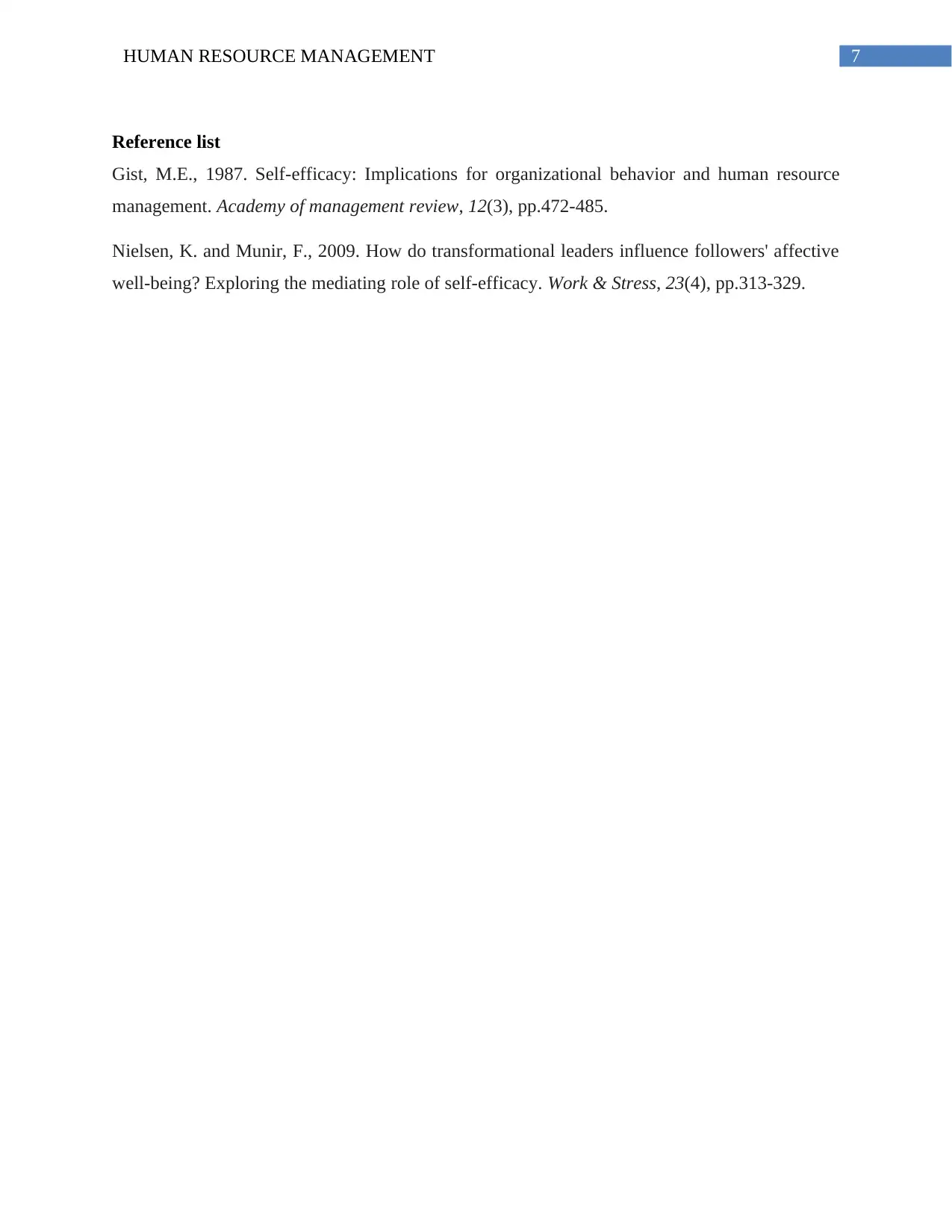
7HUMAN RESOURCE MANAGEMENT
Reference list
Gist, M.E., 1987. Self-efficacy: Implications for organizational behavior and human resource
management. Academy of management review, 12(3), pp.472-485.
Nielsen, K. and Munir, F., 2009. How do transformational leaders influence followers' affective
well-being? Exploring the mediating role of self-efficacy. Work & Stress, 23(4), pp.313-329.
Reference list
Gist, M.E., 1987. Self-efficacy: Implications for organizational behavior and human resource
management. Academy of management review, 12(3), pp.472-485.
Nielsen, K. and Munir, F., 2009. How do transformational leaders influence followers' affective
well-being? Exploring the mediating role of self-efficacy. Work & Stress, 23(4), pp.313-329.
1 out of 8
Related Documents
Your All-in-One AI-Powered Toolkit for Academic Success.
+13062052269
info@desklib.com
Available 24*7 on WhatsApp / Email
![[object Object]](/_next/static/media/star-bottom.7253800d.svg)
Unlock your academic potential
Copyright © 2020–2025 A2Z Services. All Rights Reserved. Developed and managed by ZUCOL.





